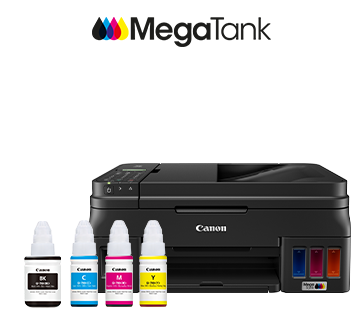PIXMA G4010

Print Head/Consumables |
|
Number of Nozzles |
Total 1,472 nozzles |
Ink Bottles (Type/Colours) |
GI-790 |
Print Heads |
BH-7, CH-7
|
Maximum Print Resolution |
4,800 (Horizontal)*1 x 1,200 (Vertical) dpi |
Print Speed*2 (Approx.) Click here for summary report
|
|
Document (ESAT/Simplex)*3 |
8.8 / 5 ipm (Mono/Colour) |
Document (FPOT Ready/Simplex)*4 |
11 / 17 sec (Mono/Colour) |
Photo (4 x 6") (PP-201/Borderless)*5 |
60 sec |
Print Width |
Bordered: Up to 203.2 mm (8")
|
Recommended Printing Area |
Top margin: 31.2 mm
|
Scanner Type |
Flatbed (ADF/Platen) |
Scanner Technology |
Contact Image Sensor (CIS) |
Optical Resolution*7 |
600 x 1,200 dpi |
Scanning Bit Depth (Input/Output) |
|
Greyscale |
16 bit / 8 bit |
Colour |
48 bit / 24 bit (RGB each 16 bit / 8 bit) |
Maximum Document Size |
|
Flatbed |
A4, LTR (216 x 297 mm) |
ADF |
A4, LTR, LGL |
Copy Speed*8 (Approx.) Click here for summary report
|
|
Document (Colour): (sFCOT/Simplex)/(sESAT/Simplex) |
24 sec / 3.5 ipm |
Document (ADF): Mono/Colour (ESAT/Simplex) |
8 / 2.5 ipm |
Maximum Copies |
99 pages |
Maximum Document Size |
|
Flatbed |
A4, LTR |
ADF |
A4, LTR, LGL |
Type |
Desktop Transceiver (Super G3/Colour Communication) |
Transmission*9 |
|
Mono |
3 sec |
Colour |
1 min |
Modem Speed |
Max. 33.6 kbps (Automatic fall back) |
Compression |
|
Mono |
MH, MR, MMR |
Colour |
JPEG |
Gradation |
|
Mono |
256 levels |
Colour |
24-bit Full Colour (RGB each 8-bit) |
ECM (Error Correction Mode) |
ITU-T T.30 compatible |
Automatic Dialling |
|
Group Dialling |
Max. 19 locations |
Transmission/Reception Memory*10 |
Approx. 50 pages |
Type |
Windows, macOS |
Mono/Colour |
B/W Transmission only |
Print Margin |
|
Borderless Printing*11 |
Top/Bottom/Left/Right margin: 0 mm |
Bordered Printing |
LTR, LGL:
|
Supported Media |
|
Rear Tray |
Plain Paper (64 - 105 g/m²)
|
Paper Size |
|
Rear Tray |
A4, A5, B5, LTR, LGL, Envelope (COM10, DL), 4 x 6", 5 x 7", 8 x 10", Square (127 x 127 mm), Business Card
|
Borderless Printing*11 |
A4, LTR, 4 x 6", 5 x 7", 8 x 10", Square (127 x 127 mm), Business Card |
Maximum Capacity |
|
Rear Tray |
Plain Paper (A4, A5, B5, LTR, 64 g/m²): 100
|
Auto Document Feeder |
Plain Paper (A4, LTR): 20
|
Paper Weight |
|
Rear Tray |
Plain Paper: 64 - 105 g/m²
|
Protocol |
TCP/IP |
Wireless LAN |
|
Type |
IEEE802.11b/g/n
|
Security |
WEP 64/128 bit
|
Direct Connection (Wireless LAN) |
Available (AP Mode only) |
Canon Printing Apps |
|
Mobile |
Canon PRINT, Easy-PhotoPrint Editor |
Others |
PosterArtist Lite, PosterArtist (Web) |
Mobile/Cloud Printing Solutions |
AirPrint®, Mopria® Print Service, Cloud Integration Service (via smartphone/tablet) |
OS System Compatibility*12 |
Windows 10 / 8.1 / 7 SP1, |
Operation Panel |
|
Display |
2-Line LCD |
Interface |
USB 2.0 |
Operating Environment*13 |
|
Temperature |
5 - 35°C |
Humidity |
10 - 90% RH (no dew condensation) |
Recommended Environment*14 |
|
Temperature |
15 - 30°C |
Humidity |
10 - 80% RH (no dew condensation) |
Storage Environment |
|
Temperature |
0 - 40°C |
Humidity |
5 - 95% RH (no dew condensation) |
Quiet Mode |
Available |
Acoustic Noise*15 |
|
Plain Paper (A4, Mono) |
53.5 dB(A) |
Power Requirements |
AC 100 - 240 V, 50/60 Hz |
Power Consumption (Approx.) |
|
OFF |
0.2 W |
Standby |
0.9 W |
Operation*16 |
10 W |
Dimensions (W x D x H) |
|
Factory Configuration |
445 x 330 x 197 mm |
Output/ADF Trays Extended |
445 x 526 x 249 mm |
Weight |
7.3 kg |
Disclaimer